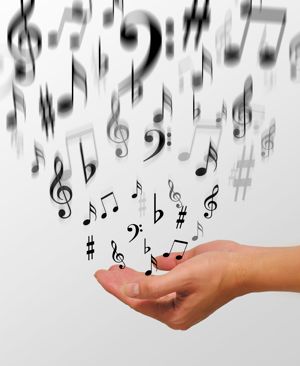A magazine where the digital world meets the real world.
On the web
- Home
- Browse by date
- Browse by topic
- Enter the maze
- Follow our blog
- Follow us on Twitter
- Resources for teachers
- Subscribe
In print
What is cs4fn?
- About us
- Contact us
- Partners
- Privacy and cookies
- Copyright and contributions
- Links to other fun sites
- Complete our questionnaire, give us feedback
Search:
MP3: something's gotta change!

The music industry has gone through a massive upheaval as a result of digital music, and more and more interactive music services, from iTunes and spotify to sonarflow, appear all the time. If the revolution is to continue at the same pace though something's gotta change!
The original digital music revolution wasn't just on the back of the idea of recording and storing music digitally but because everyone agreed on a common music format - the MP3 format. MP3 is just a particular code for storing music digitally - as strings of 1s and 0s. There are lots of different ways of doing that, and if different record companies were to release music using different formats - a different code - it would be chaos. Everyone would need lots of different players and worse need to know which one was needed to play which tracks. Confusion would reign. Having a common format means that anyone who has an MP3 player can play any music. Better still, it means anyone with a great new idea can create a new service based on it and everyone else will have the capability to use it. The trouble is there is a lot you can't easily do with MP3 so some great ideas just won't get off the ground if we stick with it.
The thing about MP3 is that it follows the tradition of CDs and records, and only stores the music in its final mixed form. When music is recorded lots of different tracks are recorded separately. In the simplest situation, for example the vocals and the music might be recorded and stored separately. In reality many more tracks than that are recorded - each separate instrument might be recorded separately for example. The producer then mixes the tracks together to give the final music that you download.
Because all the music has been integrated into mixed tracks before it is distributed means digital music isn't very flexible at the moment. If instead all the original tracks were separately available in the stored music file lots of new applications would be possible. That is what the new 'Interactive Music Application Format' known as 'IM AF' does. It is the brainchild of an organisation known as MPEG - the Moving Pictures and Associated Audio Experts Group - the same group that came up with MP3 in the first place.
IM AF allows you to store and share music as lots of audio tracks and combine it with other information too. That creates lots of exciting possibilities for new ways of experiencing music. Listeners can listen to different music producer mixes of the same music, for example - just store the mix settings in the IM AF file. This kind of multi-track interactive music format allows you to do more than listen passively though. You can also interact with it. For example, why not experiment with your own mixes? Lots of things become simple to do. To create a Karaoke version of a single to sing along to you just pick out the music tracks and drop the vocals. To practice your musical instrument skills isolate the instruments you want to play along with - either the one you are playing or some others to accompany you. You could also emphasize the melody, harmony, or rhythm of a particular piece of music depending upon your personal tastes. If you don't want to do all this yourself, don't worry, as services will spring up to make these ideas and more easy, or do it at the touch of a button. Ways to legally share your modified versions with your friends also become a possibility if some budding entrepreneur wants to set up a service to support it.
This simple idea of a change in the way music is stored means not only that music listening becomes more flexible, but we could all become creative music producers if we want to. Better still if you want to be a digital music entrepreneur, a whole new space of ideas for services is just around the corner.


